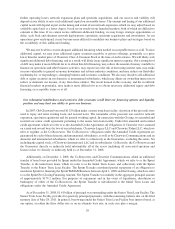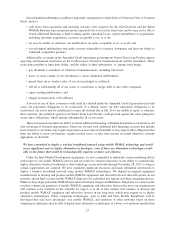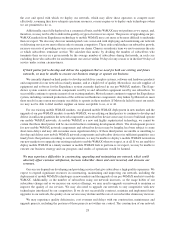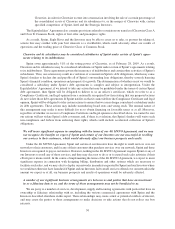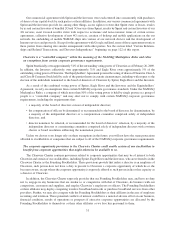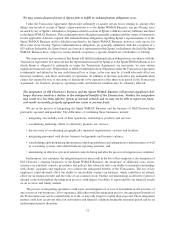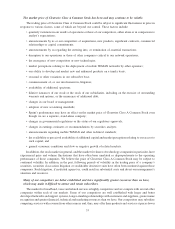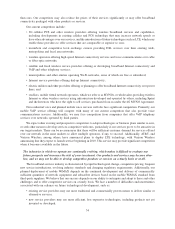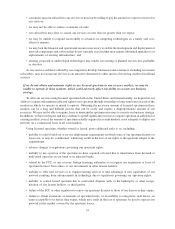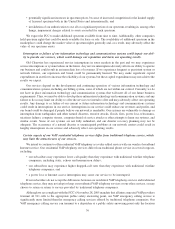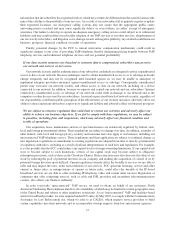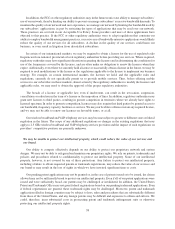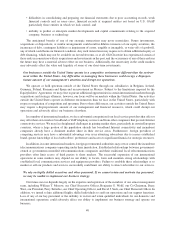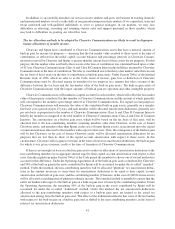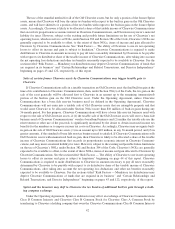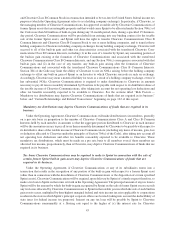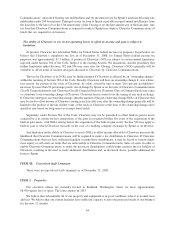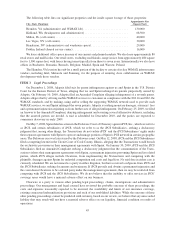Clearwire 2008 Annual Report Download - page 47
Download and view the complete annual report
Please find page 47 of the 2008 Clearwire annual report below. You can navigate through the pages in the report by either clicking on the pages listed below, or by using the keyword search tool below to find specific information within the annual report.• consumers may not su
b
scr
ib
e to our serv
i
ces or may not
b
ew
illi
ng to pay t
h
e amount we expect to rece
i
ve
f
o
r
our services;
• we may not
b
ea
bl
e to rea
li
ze econom
i
es o
f
sca
l
e;
• our subscribers ma
y
elect to cancel our services at rates that are
g
reater than we expect
;
•wema
yb
e una
bl
e to respon
d
success
f
u
lly
to a
d
vances
i
n compet
i
n
g
tec
h
no
l
o
gi
es
i
nat
i
me
ly
an
d
cost-
e
ffective manner
;
• we may
l
ac
k
t
h
e
fi
nanc
i
a
l
an
d
operat
i
ona
l
resources necessary to ena
bl
et
h
e
d
eve
l
opment an
dd
ep
l
oyment o
f
n
etwor
k
components an
d
so
f
tware t
h
at
d
o not current
ly
ex
i
st an
d
t
h
at ma
y
requ
i
re su
b
stant
i
a
l
up
g
ra
d
es to o
r
replacements of existin
g
infrastructure; and
•ex
i
st
i
ng, propose
d
or un
d
eve
l
ope
d
tec
h
no
l
og
i
es may ren
d
er our ex
i
st
i
ng or p
l
anne
d
serv
i
ces
l
ess pro
fi
ta
ble
or obsolete
.
As our serv
i
ces an
d
t
h
ose o
ff
ere
db
y our compet
i
tors
d
eve
l
op,
b
us
i
nesses an
d
consumers,
i
nc
l
u
di
ng our current
s
ubscribers, ma
y
not accept our services as an attractive alternative to other means of receivin
g
wireless broadban
d
s
erv
i
ces
.
If
we
d
o not o
b
tain an
d
maintain rig
h
ts to use
l
icense
d
s
p
ectrum in one or more mar
k
ets, we ma
ybe
u
na
bl
etoo
p
erate in t
h
ese mar
k
ets, w
h
ic
h
cou
ld
a
d
verse
ly
a
ff
ect our a
b
i
l
it
y
to execute our
b
usines
s
s
t
ra
t
egy
.
T
o offer our services using licensed spectrum both in the United States and internationally, we depend on our
a
bili
t
y
to acqu
i
re an
d
ma
i
nta
i
nsu
ffi
c
i
ent r
igh
ts to use spectrum t
h
rou
gh
owners
hi
por
l
on
g
-term
l
eases
i
n eac
h
o
f
t
he
m
arkets in which we operate or intend to operate. Obtainin
g
the necessar
y
amount of licensed spectrum in these
m
arkets can be a long and difficult process that can be costly and require a disproportionate amount of our
r
esources. We ma
y
not
b
ea
bl
e to acqu
i
re,
l
ease or ma
i
nta
i
nt
h
e spectrum necessar
y
to execute our
b
us
i
ness strate
gy
.
In addition, we have in the past and ma
y
continue to spend si
g
nificant resources to acquire spectrum in additional o
r
e
xistin
g
markets, even if the amount of spectrum actuall
y
acquired in certain markets is not adequate to deplo
y
our
n
et
w
or
k
on a commerc
i
a
lb
as
i
s
i
na
ll
suc
h
mar
k
ets
.
Usin
g
licensed spectrum, whether owned or leased, poses additional risks to us, includin
g:
•
i
na
bili
t
y
to sat
i
s
fy b
u
ild
-out or serv
i
ce
d
ep
l
o
y
ment requ
i
rements on w
hi
c
h
some o
f
our spectrum
li
censes o
r
leases are, or ma
y
be, conditioned, which ma
y
result in the loss of our ri
g
hts to the spectrum sub
j
ect to the
requirements;
• adverse chan
g
es to re
g
ulations
g
overnin
g
our spectrum ri
g
hts;
•
i
na
bili
t
y
to use a port
i
on o
f
t
h
e spectrum we
h
ave acqu
i
re
d
or
l
ease
dd
ue to
i
nter
f
erence
f
rom
li
cense
d
o
r
u
n
li
cense
d
operators
i
n our
b
an
d
or
i
na
dj
acent
b
an
d
s;
•re
f
usa
lb
yt
h
e FCC, or one or more
f
ore
i
gn
li
cens
i
ng aut
h
or
i
t
i
es to recogn
i
ze our acqu
i
s
i
t
i
on or
l
ease o
f
s
pectrum
li
censes
f
rom ot
h
ers or our
i
nvestments
i
not
h
er
li
cense
h
o
ld
ers
;
•
i
na
bili
ty to o
ff
er new serv
i
ces or to expan
d
ex
i
st
i
ng serv
i
ces to ta
k
ea
d
vantage o
f
new capa
bili
t
i
es o
f
our
n
etwor
k
resu
l
t
i
ng
f
rom a
d
vancements
i
n tec
h
no
l
ogy
d
ue to regu
l
at
i
ons govern
i
ng our spectrum r
i
g
h
ts;
• inabilit
y
to control leased spectrum due to contractual disputes with, or the bankruptc
y
or other reor
g
a-
ni
zat
i
on o
f
,t
h
e
li
cense
h
o
ld
ers, or t
hi
r
d
part
i
es;
•
f
a
il
ure o
f
t
h
e FCC or ot
h
er re
g
u
l
ators to renew our spectrum
li
censes or t
h
ose o
f
our
l
essors as t
h
e
y
exp
i
re
;
•
f
a
il
ure to o
b
ta
i
n extens
i
ons or renewa
l
so
f
spectrum
l
eases, or an
i
na
bili
t
y
to rene
g
ot
i
ate suc
hl
eases, o
n
terms accepta
bl
etous
b
e
f
ore t
h
e
y
exp
i
re, w
hi
c
h
ma
y
resu
l
t
i
nt
h
e
l
oss o
f
spectrum we nee
d
to operate ou
r
n
etwork in the market covered b
y
the spectrum leases;
35



